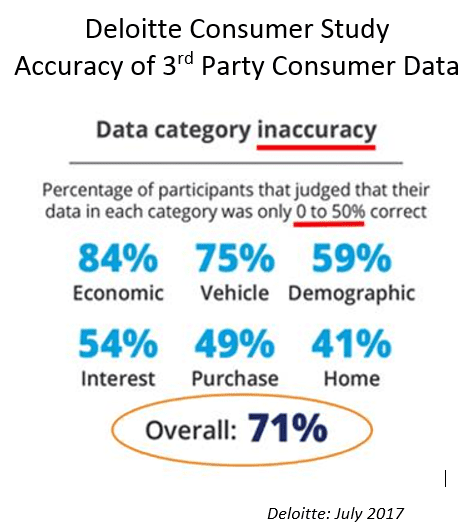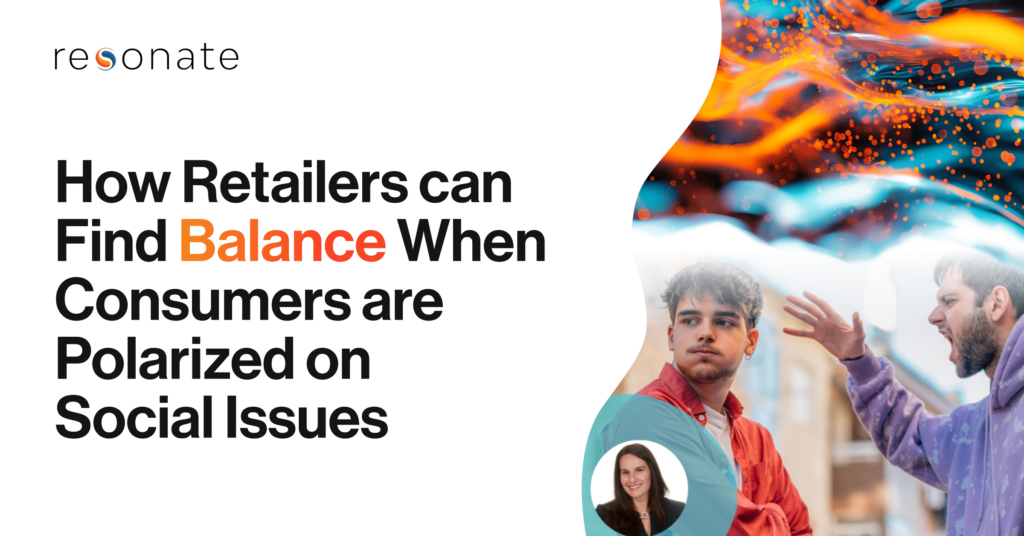Take it from Deloitte: What 3rd Party Data Providers & Exchanges Aren’t Telling You
Unless you are in direct response advertising, one could argue that “Precision” should be one of the many marketing “P’s.” We are all taught in Marketing 101 that we should be operating from accurate data in order to effectively target our audiences. However, it’s not until Marketing 320 that we understand just how costly “dirty data” can be, and the substantial value of data accuracy.
In a multi-part series, Resonate is addressing the problem of dirty, messy, confusing and just plain bad consumer marketing data and the challenges marketers face. In trying to effectively target the right audiences, they are making some costly trade-offs and running the risk of misfires and wasted media spend.
You’ll be surprised by the secrets we reveal, but first, let’s hear from a leading expert.
Deloitte Takes on Dirty Marketing Data Head On – Going Right to Consumers
In late July, Deloitte released a report, entitled “Predictably inaccurate: The prevalence and perils of bad big data”, which revealed just how inaccurate the data from 3rd party data providers and aggregators can be.
Deloitte’s research came directly from consumers who were asked to review the data about them from a leading consumer data broker. The consumer study focused on six major data categories to include demographic, economic, interest, purchase, home and vehicle.
Their overall key finding only 29% of the data on these consumers as a whole was more than 50% accurate.
“It’s pretty scary how wrong data collected about you can be—especially if people make important decisions based on this incorrect information. This becomes more frightening as more and more decisions become information-based.” Deloitte Survey Respondent
Results by category are below. Remember, these numbers represent the percentage where the data was only 0-50% accurate.

Truly scary, only 59% of consumers found their demographic data to be up to 50% accurate. This includes seemingly easily available data points such as age, gender, income, marital status, as well as home and car ownership from public records.
Add in the inaccuracy in interests, media consumption, purchasing behavior and any type of psychographics and you have a marketing nightware. Unfortunately, these data points are some of the most vital basics for marketers looking to target the right consumers.
How Consumer Data Gets “Dirty”
Deloitte’s Stated reasons on how consumer data becomes so inaccurate:
- Outdated or incomplete information may persist due to the cost and/or effort of obtaining up-to-date information
- An organization that uses multiple data sources may incorrectly interweave data sets and/or be unaware of causal relationships between data points and lack proper data governance mechanisms to identify these inconsistencies
- Relying solely on self-reported data versus observed (actual) behaviors
- Incorrect inferences about consumers’ interests (for example, inferring that the purchase of a hang-gliding magazine suggests a risky lifestyle when the purchaser’s true motive is an interest in photography)
- Use of biased sample populations
- Asking leading or evaluative questions that increase the likelihood of demand effects (for example, respondents providing what they believe to be the “desired” or socially acceptable answer versus their true opinion, feeling, belief, or behavior)
- Gathering responses in tense or public environments where consumers do not feel an assurance of anonymity
Compounding factors:
- Misattribution of values, motivations, and interests due to unsubstantiated inferences, and
- Faulty models with false assumptions, proxies, and causal relationships.
The Consequences of Inaccurate Data
This is obvious. Poor data, poor results. Deloitte’s conclusion was that commonly sold 3rd party consumer data will remain inaccurate, which leads marketers to missed opportunities and potentially brand harmful missteps.
We all heard about P&G’s marketing blunder with Gillette sending razors to women and older men when intended for 18 year old men. Just one simple demographic needed. How could one of the most prestigious brands get one of the most basic demographic data points wrong? Brand relevance, reputation, credibility and loyalty, not to mention the tremendous wasted ad spend are just a few of the “costs” of operating from bad data.
And, inaccurate data doesn’t just have implications for marketers and consumer insights professionals. Purchased 3rd party data, even when combined with a companies 1st party data, is what many organizations rely on for strategic business decisions, research and development, as well as product management and other key areas of the business.
It is obvious why dirty or inaccurate data is a problem, especially when consumers now expect you to know who they are and what they want with personalized and relevant experience. Here are some implications Deloitte points out.
- Poor targeting and micro-targeting
- Irrelevant creative and messaging, even wrong or inappropriate
- Embarrassing levels of personalization
- Wrong-time media delivery
- Wasted media dollars
- Risk to brand affinity, intent, purchase and loyalty
- Lack of competitive differentiation
While much of the responsibility for dirty data rests with data providers and exchanges that collect data poorly or rely on other 3rd party resources, with no promise of accuracy. However, buyers must also take responsibility for understanding the causes and effects of bad data on their marketing programs in order to choose the right data partners.
In our next post, we conducted our own experiment using my publicly available consumer data from one of the most prominent DMP’s, a leading 3rd party data provider, as well as Resonate’s own data. It was a fun experiment and one you can conduct yourself as well.
Until then, stay hungry for accurate and relevant data!
Haidee Hanna, Vice President of Marketing
Kelly Tsao, Marketing Associate
All quoted sections, images, and research in this article is copyright of Deloitte Development LLC, and publicly available through the complimentary article reprint from Deloitte Review, Issue 21 July 2017.
Contact Resonate to accelerate the ability to accurately identify the right customers or prospects, understand what they care about, know what to say to them, and find more of them across all marketing channels with precision and at scale. Resonate is helping marketers reduce marketing complexity, drive strategy and win more business or campaigns, while reducing data costs and improving media accuracy.



